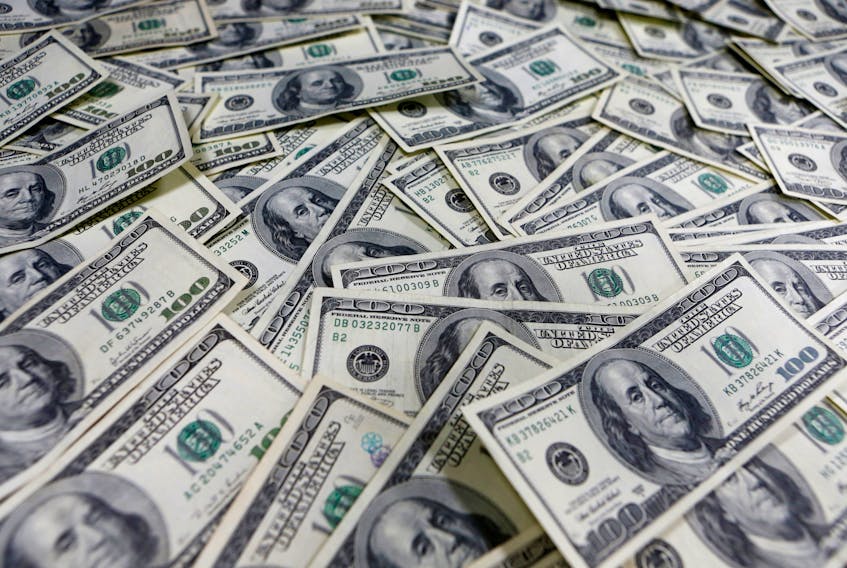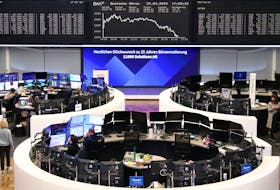By Saikat Chatterjee
LONDON (Reuters) - The cost of swapping euros and sterling for dollars in FX swap markets fell on Monday to the lowest in over a decade in a sign of success for central banks' operations, though some other indicators imply money market stress has not wholly dissipated.
The swap moves follow a series of policy efforts to squelch the strains in dollar funding markets, including the U.S. Federal Reserve's dollar swap lines for many foreign central banks and offer of temporary 'repo' facilities for others who lack access to such lines.
These actions reversed the surge in dollar borrowing costs overseas. Three-month euro-dollar FX swaps
Essentially that means European entities are now able to source greenbacks at a discount, rather than paying large premia. This in itself is an anomaly of sorts because a swap market premium for dollars has been a feature of the market ever since the 2008 crisis.
"Policies put in place to settle markets have created new distortions of their own," Natwest market strategists said in a note. "Judging from cross-currency basis swaps, there has been a swing from an acute dollar shortage to an oversupply."
Swap rates versus the pound
Graphic - Dollar funding markets recover from stress: https://fingfx.thomsonreuters.com/gfx/mkt/xlbvglxdpqd/Dollar%20funding1.PNG
More broadly, the reduction in dollar borrowing pressures in FX swaps hasn't dented greenback strength. The dollar index <=USD> rose 2.5% last week while it firmed 3% against the euro
What's more, there is evidence of elevated stress levels elsewhere, particularly in U.S. interbank funding markets.
For example, the cost of borrowing dollars outside the United States -- the three-month dollar LIBOR
The still-wide spreads between the two rates suggests "there is still a credit risk or a liquidity shortage in the market", said Simon Harvey, at Monex Europe, a forex broker.
Stubbornly high LIBOR rates have also spilled into interbank U.S. markets. A gauge measuring the difference between what big banks pay for longer-term financing compared to overnight funds
The spread reflects the high demand for bank loans by a variety of borrowers at a time when there is increased pressure on banks' balance sheets to cut back on risky lending, said Ilan Solot, a strategist at Brown Brothers Harriman.
Pressure on securing bank loans also is manifested in spreads between the rate on three-month commercial paper -- which U.S. companies tap for short-dated funds -- and bank lending rates are above 105 bps, compared to 24 bps at the start of 2020.
Elevated interbank funding costs "shows the onshore-offshore lending remains dysfunctional," said Marc Chandler at Bannockburn Securities in New York.
"It is this discrepancy that may help explain why the cross-currency basis swaps look so distorted now."
Graphic - FX swaps/forwards and currency swaps hedge trade, bond debt and portfolios: https://fingfx.thomsonreuters.com/gfx/mkt/rlgvdobbpoj/Dollar%20funding%202.PNG
BBH's Solot said another reason why offshore dollar borrowing costs have fallen relative to U.S. interbank markets is because these swap transactions were collateralized in a foreign currency, while much of the borrowing in the U.S. markets was on an unsecured basis.
"At worst, in the offshore market, you are stuck with a wrong currency as collateral but in the U.S., most of these borrowings don't have any collateral," he said.
The Bank for International Settlements, an umbrella group for the world's central banks, said last week there is a need to ensure dollar funds remain available to firms that are enmeshed in global supply chains and in constant need of working capital.
(Reporting by Saikat Chatterjee; Additional reporting by Olga Cotaga; Editing by Sujata Rao, Angus MacSwan and Chizu Nomiyama)









